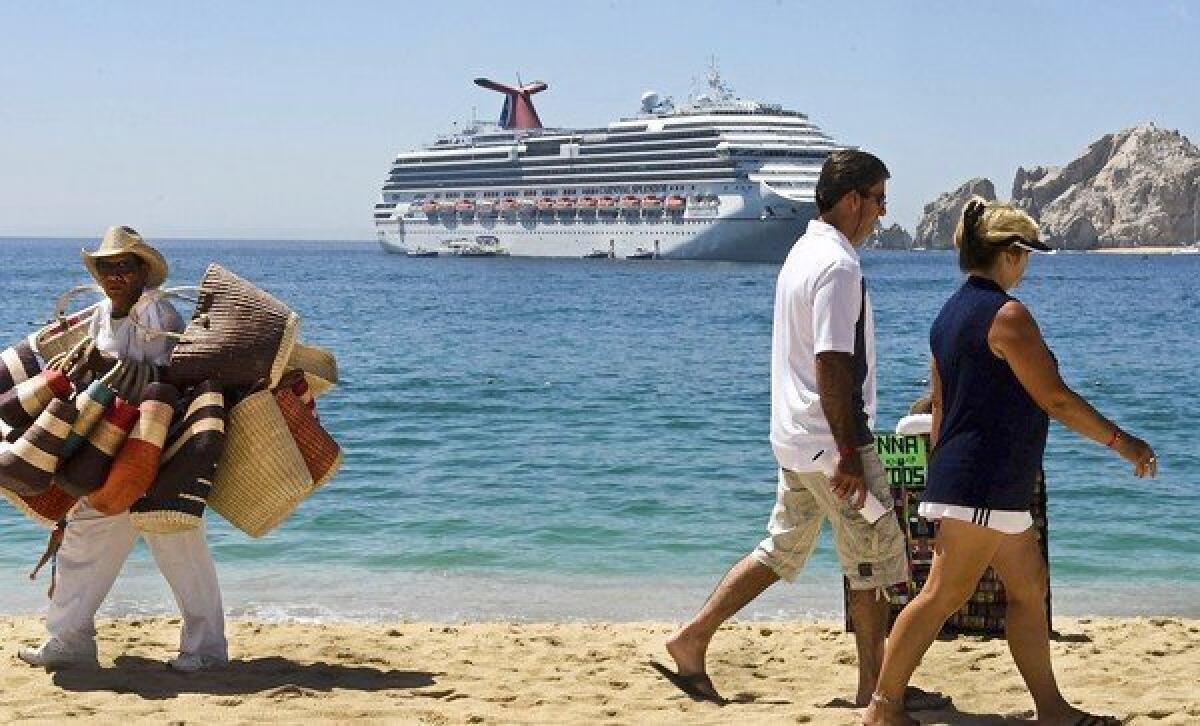Mexico tourism grows thanks to non-U.S. visitors

- Share via
Mexico predicts record tourist visits this year. But it’s not because of a surge in U.S. visitors.
Don’t get Mexico wrong. U.S. tourists still represent the lion’s share of foreign visitors, and Mexico welcomes them and their green dollar bills. But Mexico is reaching out to visitors from countries such as Russia, Brazil, Peru and Colombia after fears of drug violence and the recession reduced U.S. visitor numbers.
The effort seems to be paying off.
Based on rising tourism numbers in the first half of the year, Mexican tourism officials predict the country will host 24.7 million foreign visitors in 2012, surpassing last year’s record of 23.4 million.
The growth is good news for Mexico because tourism represents nearly 10% of the nation’s gross domestic product and the country has been living under the specter of a drug war that has killed thousands of citizens.
“Despite one of the worst financial crises in years, a flu outbreak and security challenges, we are seeing the highest tourism numbers ever,” Mexico’s secretary of tourism, Gloria Guevara, said in an interview.
In the first half of the year, Mexico saw a 77% increase in Russian visitors, a 61% jump in tourists from Brazil and a 38% bump in visitors from Venezuela, according to Mexican tourism officials. Meanwhile, the number of travelers from the U.S. dropped 1%.
Guevara attributes the uptick in foreign tourists to several changes made since 2010 by the Mexican government to reduce its dependency on U.S. tourists. Among those, she said, was allowing foreign visitors to enter the country with a U.S. visa in lieu of a Mexican visa. In addition, Mexico created an online process to review visa applications within 24 hours for travelers from Brazil, Ukraine, China and Russia and waived the need for a visa from Peruvians, Chileans and Colombians.
“It’s like having a business plan for the entire country with one goal,” Guevara said.
Besides making it easier for foreign visitors to travel to Mexico, Guevara said Mexican President Felipe Calderon has supported an investment of more than 31 billion pesos in infrastructure improvements from 2006 to 2012, a 23% increase over the previous six-year period. That total includes upgrades to many roads, including the route between Mexico City and the tourist town of Oaxaca, reducing the travel time from eight hours to about four.
The country has not given up on the U.S., which still represents 70% of all tourists traveling by air to Mexico. But Guevara said Mexico’s federal government realized the country was too dependent on its neighbors to the north for tourism spending.
“In 2010, President Calderon shook things up,” she said.
Now Mexico is relying more heavily on the spending of visitors like Eliana Garzon, an electrical engineer from Cali, Colombia, who has visited the beach town of Cancun three times in the last few years, most recently in June, with her husband and 9-year-old daughter.
She said she enjoys the relaxed setting and the family-friendly atmosphere in Mexico.
Garzon said she feels safe visiting Mexico.
“We asked if it was safe and were told Cancun is the safest area,” she said. “Besides, Colombia has struggled with drug violence but we feel safe there anyway.”
The most recent travel warning from the U.S. Department of State said the Mexican government makes an effort to protect visitors in tourist destinations. But the warning said the number of U.S. citizens reported murdered in Mexico increased from 35 in 2007 to 120 in 2011.
Drug violence, a swine flu outbreak and the global economic crisis have all helped push down the number of U.S. visitors to Mexico in the last few years. In 2011, the number dropped to 19.9 million, compared with 20.3 million in 2008, according to the U.S. Office of Travel and Tourism Industries.
Guevara defends Mexico, saying tourists are rarely threatened by drug violence.
“Ask someone who has been in Mexico yesterday, a week ago or a year ago,” she said. “Our tourist destinations are fine, but we have hot spots like in the U.S.”
U.S. tourists who visit Mexico say they are aware of the drug violence south of the border and take precautions while in the country.
Larkin Smith, a retired medical worker from San Marcos, Texas, said he is planning a trip in the next few weeks with his wife and several friends to Nuevo Vallarta to golf, shop and relax. But he said he plans to stay close to their time-share resort and away from non-tourist areas, particularly at night.
“I’m very concerned with safety,” he said. “We’re of the older generation and have no plans to take those kinds of chances.”
More to Read
Sign up for The Wild
We’ll help you find the best places to hike, bike and run, as well as the perfect silent spots for meditation and yoga.
You may occasionally receive promotional content from the Los Angeles Times.






